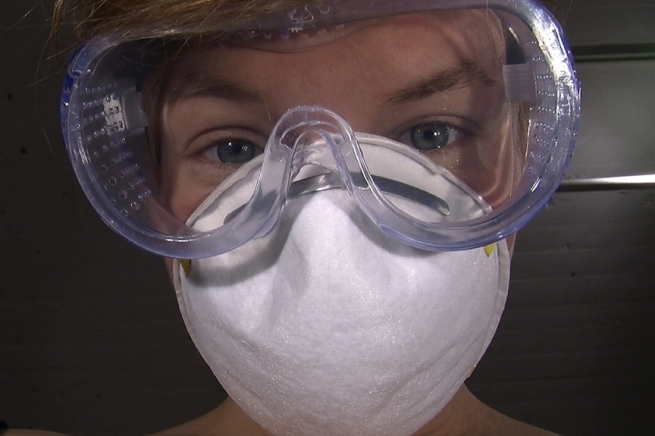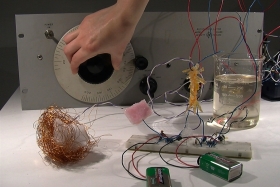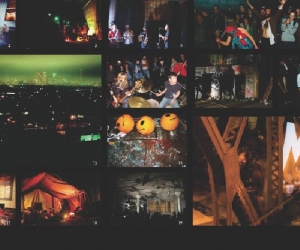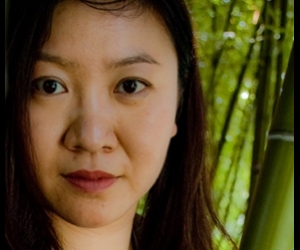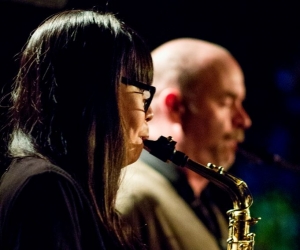Erin Sexton is in awe of the universe. By situating her creative practice in relation to the stars and the planets, the Montreal sound artist seeks to engage in conversations with the cosmos. Her work is grounded in the hard materials we know as nature, electricity, and the elements. She employs matter, energy, space, and time in performance and for installations and video art. Her aim is nothing less than to facilitate sonic encounters with the sublime.
Sexton grew up in British Columbia, where her grandfather would give ham radio demonstrations to his grandkids. “He was a real tinkerer and always had a lot of gadgets around, and police scanners. It was super inspiring and he would say things like, ‘When it’s late at night and the atmosphere is really clear, sometimes I can bounce a signal off the ionosphere and talk to someone in Africa!’ ” This struck a chord in Sexton, and she became acclimated to the physics of sound at an early age. While studying film-sound design at Emily Carr University, Sexton became passionate about sound in an artistic, musical sense. “I was kind of reactionary,” she recalls. “At one point, the prof said the purpose of sound in film is to efface itself. I had this deep relationship to sound already, and kind of rebelled against that notion. I started making video art where images were in the background and there to serve the sound. That’s what got me really playing and experimenting with and focusing on sound.”
Stepping into Sexton’s studio and laboratory for the first time, I am not surprised to learn that her father was a science teacher. Beakers, crystal solutions, sponges, homemade circuits, and other materials are all around. Prototypes for future circuits are in development, with a small farm of test crystals growing from them. Epsom salt and sodium borate (borax) are there, too. “Salt and borax open up possibilities to continue making work under a variety of economic conditions,” she says. “But I also love to work that way just because it is very immediate and direct. I feel like anybody can understand something about my work because it’s technologically very simple. It’s raw. It’s ubiquitous. It’s not expensive. It’s the salt in your cupboard, and the most basic five-component circuit that anybody can be taught how to build.”
There is an understated ethic underlying Sexton’s practice. She has worked with the same circuit for ten years, finding, she says, “endless complexity in one very simple thing. And every time, I go deeper or change the input, change the sensor. I am exploring something and finding endless variations and complexity unfolding, without complexifying my schematic at all. We don’t live in a world where you draw a line from point A to point B. We live in a world of looping causal relationships, and everything is affecting everything else. It’s very complex and rich. You don’t need to do much to find that.”
Sexton’s goal of engaging with the world that surrounds us is itself crystalline. She is interested too in the role of the self in this context. “It’s more a questioning of what is self. What is it to be? To relate to objects? What is it to have your self? What is self?” For Sexton, in many ways, this line of questioning is about her relationship to nature. “Nature is very indifferent. It’s on a different time scale. It’s indifferent to us. We can try to make ourselves comfortable by projecting our desires and our emotions onto nature but, eventually, if you sit with that thought long enough, you’ll realize that it’s not the case. By growing crystals and trying to figure out how that process works, I saw how slowly it happened. It wasn’t giving anything back to me, and I was like, ‘Okay, that’s me projecting my subjectivity onto nature, and that doesn’t work.’ ”
Sexton’s Crystalline Domain is a body of installation works involving crystallization with custom electronics. “I use Epsom salt because it already has a strong link to the body, it’s commonly used to soak tired muscles. Borax is a natural cleaning product, and also has a very interesting controversy surrounding its other possible health benefits,” she explains. “Through my research it became clear that the pharmaceutical industry systematically attacks the credibility of simple, inexpensive home remedies, sometimes even prohibiting their use. Chemistry has unlocked the power of the natural world, but unfortunately it is now used too often as a method of synthesizing, altering, and patenting nature’s benefits, in the service of profit. I find this deeply troubling, and am exploring ways of approaching this subject through my work.”
At one of Sexton’s performances, one is likely to see items similar to those found in her studio and lab: a magnetic stirring hotplate, tactile electronic circuits, a mess of wires, contact mikes, beakers, salt, and crystals. With these tools she connects listeners to the sound waves that surround us, and generates what she calls “a direct experience of electricity of matter. These things are difficult to comprehend, but somehow we can experience them through sound.”
In his book Earth Sound Earth Signal: Energies and Earth Magnitude in the Arts (University of California Press, 2013), media-arts and experimental-music theorist Douglas Kahn describes these resonances:
The universe is made of a single eternal substance, eternally vibrating in an infinite range of frequencies. Everything we know is something vibrating: the universe is like a vast orchestra playing an eternal music of millions of octaves combined into an infinite variety of melodies and harmonies.
Sexton cites cosmic background radiation, or “cosmic frequencies,” as an example. “We can’t hear them, but through the medium of sound we can transpose them to a level where we can actually hear a transduction of cosmic frequencies—a transduction of all of these intangible things physically through sound. Sound opens up a possibility for us to have an embodied experience of things that are intangible otherwise. I am interested in working between experience and science and the body. Theoretical physicists and cosmologists have made all these huge discoveries about the nature of the universe and the scale of the cosmos.”
Witnessing a performance by Erin Sexton is like being bathed in a blanket of radio waves. The random comes alive. There may be stillness, but silence is not often a component. “Silence is relative. It’s more of a conceptual thing than a physical thing. John Cage proved that even in an anechoic chamber you still hear the blood circulation and the heartbeat. Silence, real silence, can exist in the vacuum of space. But silence, in a way, is death. It’s like the absence of change. In the same way, I find crystals to be related to death because of of what a crystal is—matter in its most structured form: there’s no more flux; there’s no more change; it’s rigidly locked and static. And life exists in the liquid state, in flux. Life really exists between the gas and the solid and the liquid. It’s a combination of all of these things.”
“Sound is the cell of inhabiting, it is the relationship between being and environment, it is dwelling,” writes sound artist Salomé Voegelin in her book Listening to Noise and Silence: Towards a Philosophy of Sound Art (Continuum, 2010). How Sexton inhabits the sound environments she creates is not simply an act of dwelling, but is also an act of dynamic interaction. Sexton acknowledges the fleeting nature of this in her pursuit of the sublime.
“We are inseparable from the elements, as they were all formed inside ancient stars, supernova-ed across the galaxy, eventually swirling and condensing into the planet we call Earth, which we and all life emerged from,” she explains. “These same elements are constantly being recycled by the Earth and our bodies, and the self is in a constant state of flux on every level—mind and metabolism alike. These thoughts are dizzying, overwhelming, and inspiring, with so much potential to humble and transform us: but rarely do they cross over into our everyday lives. In my work I explore different ways of embodying these cosmic and natural phenomena, trying to help bridge the gap between knowledge and lived experience.”
Outside of her solo practice, Sexton is part of the Montreal collective Fünf. Its membership includes founder Magali Babin, Martine H. Crispo, Émilie Mouchous, Anne-Françoise Jacques, and Andrea-Jane Cornell. “There’s a lot of amazing, really talented, strong female sound artists in Montreal, and that’s something that we wanted to celebrate. And all of the members have their own careers and solo practices. It’s been both a challenge and rewarding to learn to pace ourselves, and to step back and give space.” In its live performances, Fünf follows a model of structured improvisation. “We make markers for ourselves, and there’s always room for other things to happen. It’s never the same, but we sort of have a basic shape that the performance will take, and then we improvise within that. That’s our most successful format.” Fünf has several projects in the works and will release a recording later in 2014.
Through both her collaborations and her study of scientific research related to her own work, Sexton has developed a respect for different approaches and for the interdisciplinary. “We’re not going to advance by closing ourselves off to possibilities and saying, ‘No, that can’t be true!’ If we test it not to be true a million times over, sure—unless we arrive at some other contradictory conclusion; then we go back and question it again. But always to remain open— that’s how things are going to get better!”
Erin Sexton performs on Saturday, Aug. 2, 2014 at the Electric Eclectics festival in Meaford, Ontario.
Audio: For MA. (Electrochemical improvisation by Erin Sexton, using water, epsom salt, oscillators, electromagnetic amplifiers, copper wire, and nine-volt batteries.) Homepage image: Epsom salt solution turning to copper sulfate by electrolysis with audio circuits, in Erin Sexton’s studio in 2014. Images: (Top) Left half and (bottom) right half of video still from Sexton’s multimedia installation work Crystalline Domain. All photos by: Erin Sexton.
